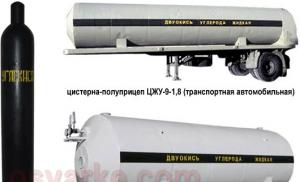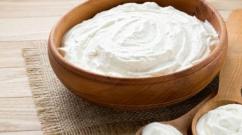Carbon dioxide application. Carbon dioxide structural chemical formula
The content of the article
CARBON DIOXIDE(carbon(IV) monoxide, carbonic anhydride, carbon dioxide) CO 2 , a well-known bubbly ingredient in carbonated soft drinks. Man has known about the healing properties of “fizzy water” from natural sources since time immemorial, but only in the 19th century. I learned to get it myself. At the same time, the substance that makes water effervescent was identified - carbon dioxide. For the first time for carbonization purposes, this gas was obtained in 1887 during the reaction between crushed marble and sulfuric acid; it was also isolated from natural sources. Later, CO 2 began to be produced on an industrial scale by burning coke, calcining limestone and fermenting alcohol. For more than a quarter of a century, carbon dioxide was stored in pressurized steel cylinders and used almost exclusively to carbonate drinks. In 1923, solid CO 2 (dry ice) began to be produced as a commercial product, and around 1940, liquid CO 2 was produced, which was poured into special sealed tanks under high pressure.
Physical properties.
At normal temperatures and pressures, carbon dioxide is a colorless gas with a slightly sour taste and odor. It is 50% heavier than air, so it can be poured from one container to another. CO 2 is a product of most combustion processes and, in sufficiently large quantities, can extinguish flames by displacing oxygen from the air. When the concentration of CO 2 increases in a poorly ventilated room, the oxygen content in the air decreases so much that a person can suffocate. CO 2 dissolves in many liquids; solubility depends on the properties of the liquid, temperature and CO 2 vapor pressure. The ability of carbon dioxide to dissolve in water determines its widespread use in the production of soft drinks. CO 2 is highly soluble in organic solvents, such as alcohol, acetone and benzene.
With increasing pressure and cooling, carbon dioxide easily liquefies and is in a liquid state at temperatures from +31 to –57 ° C (depending on pressure). Below –57°C it turns into a solid state (dry ice). The pressure required for liquefaction depends on the temperature: at +21° C it is 60 atm, and at –18° C it is only 20 atm. Liquid CO 2 is stored in sealed containers under appropriate pressure. When it passes into the atmosphere, part of it turns into gas, and some into “carbon snow,” while its temperature drops to –84 ° C.
Absorbing heat from the environment, dry ice passes into a gaseous state, bypassing the liquid phase - sublimates. To reduce sublimation losses, it is stored and transported in sealed containers that are strong enough to withstand the increase in pressure as the temperature rises.
Chemical properties.
CO 2 is a low-active compound. When dissolved in water, it forms weak carbonic acid, which turns litmus paper red. Carbonic acid improves the taste of carbonated drinks and prevents the growth of bacteria. Reacting with alkali and alkaline earth metals, as well as with ammonia, CO 2 forms carbonates and bicarbonates.
Prevalence in nature and production.
CO 2 is formed during the combustion of carbon-containing substances, alcoholic fermentation, and the rotting of plant and animal residues; it is released when animals breathe, and it is released by plants in the dark. In the light, on the contrary, plants absorb CO 2 and release oxygen, which maintains the natural balance of oxygen and carbon dioxide in the air we breathe. The CO 2 content in it does not exceed 0.03% (by volume).
There are five main ways to produce CO 2: combustion of carbon-containing substances (coke, natural gas, liquid fuel); formation as a by-product during ammonia synthesis; calcination of limestone; fermentation; pumping from wells. In the last two cases, almost pure carbon dioxide is obtained, and when burning carbon-containing substances or calcining limestone, a mixture of CO 2 with nitrogen and traces of other gases is formed. This mixture is passed through a solution that absorbs only CO 2 . Then the solution is heated and almost pure CO 2 is obtained, which is separated from the remaining impurities. Water vapor is removed by freezing and chemical drying.
The purified CO 2 is liquefied by cooling it at high pressure and stored in large containers. To produce dry ice, liquid CO 2 is fed into a closed chamber of a hydraulic press, where the pressure is reduced to atmospheric pressure. With a sharp decrease in pressure, loose snow and very cold gas are formed from CO 2. The snow is compressed and dry ice is obtained. CO 2 gas is pumped out, liquefied and returned to the storage tank.
APPLICATION
Receiving low temperatures.
In liquid and solid form, CO 2 is used mainly as a refrigerant. Dry ice is a compact material, easy to handle and allows you to create different temperature conditions. With the same mass, it is more than twice as cold as ordinary ice, occupying half the volume. Dry ice is used in food storage. It is used to cool champagne, soft drinks and ice cream. It is widely used in the “cold grinding” of heat-sensitive materials (meat products, resins, polymers, dyes, insecticides, paints, seasonings); when tumbling (cleaning from burrs) stamped rubber and plastic products; during low-temperature testing of aircraft and electronic devices in special chambers; for “cold mixing” of semi-finished muffins and cakes so that they remain homogeneous during baking; for rapid cooling of containers with transported products by blowing them with a stream of crushed dry ice; when hardening alloy and stainless steels, aluminum, etc. in order to improve their physical properties; for tight fit of machine parts during their assembly; for cooling cutters when processing high-strength steel workpieces.
Carbonization.
The main application of CO 2 gas is the carbonation of water and soft drinks. First, water and syrup are mixed in the required proportions, and then the mixture is saturated with CO 2 gas under pressure. Carbonation in beers and wines usually occurs as a result of chemical reactions occurring in them.
Applications based on inertia.
CO 2 is used as an antioxidant during long-term storage of many food products: cheese, meat, milk powder, nuts, instant tea, coffee, cocoa, etc. As a combustion suppressant, CO 2 is used in the storage and transportation of flammable materials, such as rocket fuel, oils, gasoline, paints, varnishes, and solvents. It is used as a protective medium in electric welding of carbon steels in order to obtain a uniform, strong weld, while welding work is cheaper than when using inert gases.
CO 2 is one of the most effective means of extinguishing fires that occur when flammable liquids ignite and electrical breakdowns. Various carbon dioxide fire extinguishers are produced: from portable ones with a capacity of no more than 2 kg to stationary automatic supply units with a total cylinder capacity of up to 45 kg or low-pressure gas tanks with a capacity of up to 60 tons of CO 2. Liquid CO 2, which is under pressure in such fire extinguishers, when released, forms a mixture of snow and cold gas; the latter has a higher density than air and displaces it from the combustion zone. The effect is also enhanced by the cooling effect of snow, which, evaporating, turns into gaseous CO 2.
Chemical aspects.
Carbon dioxide is used in the production of aspirin, white lead, urea, perborates, and chemically pure carbonates. Carbonic acid, formed when CO 2 is dissolved in water, is an inexpensive reagent for neutralizing alkalis. In foundries, carbon dioxide is used to cure sand molds by reacting CO 2 with sodium silicate mixed with sand. This allows you to obtain higher quality castings. Refractory bricks used to line furnaces for smelting steel, glass and aluminum become more durable after treatment with carbon dioxide. CO 2 is also used in urban water softening systems using soda lime.
Creation of increased pressure.
CO 2 is used for pressure testing and leak testing of various containers, as well as for calibrating pressure gauges, valves, and spark plugs. It is used to fill portable containers for inflating life belts and inflatable boats. A mixture of carbon dioxide and nitrous oxide has long been used to pressurize aerosol cans. CO 2 is injected under pressure into sealed containers with ether (in devices for quick engine starting), solvents, paints, insecticides for subsequent spraying of these substances.
Application in medicine.
CO 2 is added in small quantities to oxygen (to stimulate breathing) and during anesthesia. In high concentrations it is used for the humane killing of animals.
Carbon dioxide CO 2(carbon dioxide, carbon dioxide, carbon dioxide, carbonic anhydride) depending on pressure and temperature can be in a gaseous, liquid or solid state.
In its gaseous state, carbon dioxide is a colorless gas with a slightly sour taste and odor. The Earth's atmosphere contains about 0.04% carbon dioxide. Under normal conditions, its density is 1.98 g/l - approximately 1.5 times the density of air.
Diagram. Phase equilibrium of carbon dioxide
Liquid carbon dioxide (carbon dioxide) is a colorless, odorless liquid. At room temperature it exists only at pressures above 5850 kPa. The density of liquid carbon dioxide is highly dependent on temperature. For example, at temperatures below +11°C, liquid carbon dioxide is heavier than water; at temperatures above +11°C, it is lighter. As a result of the evaporation of 1 kg of liquid carbon dioxide under normal conditions, approximately 509 liters of gas are formed.
At a temperature of about -56.6 ° C and a pressure of about 519 kPa, liquid carbon dioxide turns into a solid - "dry ice".
In industry, there are 3 most common ways to produce carbon dioxide:
- from waste gases of chemical production, primarily synthetic ammonia and methanol; the exhaust gas contains approximately 90% carbon dioxide;
- from flue gases of industrial boiler houses burning natural gas, coal and other fuels; flue gas contains 12-20% carbon dioxide;
- from waste gases formed during fermentation in the process of producing beer, alcohol, and during the breakdown of fats; the exhaust gas is almost pure carbon dioxide.
According to GOST 8050-85, gaseous and liquid carbon dioxide is supplied in three types: premium, first and second grade. For welding, it is recommended to use carbon dioxide of the highest and first grade. The use of second grade carbon dioxide for welding is allowed, but the presence of gas dryers is desirable. The permissible content of carbon dioxide and some impurities in various brands of carbon dioxide is given in the table below.

Table. Characteristics of carbon dioxide brands
Safety precautions when working with carbon dioxide:
- Carbon dioxide is not toxic and not explosive, however, when its concentration in the air exceeds 5% (92 g/m3), the proportion of oxygen decreases, which can lead to oxygen deficiency and suffocation. Therefore, you should be wary of its accumulation in poorly ventilated areas. To record the concentration of carbon dioxide in the air of industrial premises, gas analyzers are used - stationary automatic or portable.
- When the pressure decreases to atmospheric pressure, liquid carbon dioxide turns into gas and snow with a temperature of -78.5°C and can lead to damage to the mucous membrane of the eyes and frostbite of the skin. Therefore, when taking samples of liquid carbon dioxide, it is necessary to use protective glasses and gloves.
- Inspection of the internal container of a previously used tank for storing and transporting liquid carbon dioxide must be carried out using a hose gas mask. The tank must be warmed to ambient temperature, and the internal container must be purged with air or ventilated. The gas mask may not be used until the volume fraction of carbon dioxide inside the equipment drops below 0.5%.
Use of carbon dioxide in welding
Carbon dioxide is used as an active shielding gas for arc welding(usually in semi-automatic welding) with a consumable electrode (wire), including as part of a gas mixture (with oxygen, argon).
Welding stations can be supplied with carbon dioxide in the following ways:
- directly from an autonomous carbon dioxide production station;
- from a stationary storage vessel - with significant volumes of carbon dioxide consumption and the enterprise does not have its own autonomous station;
- from the transport carbon dioxide tank - with smaller volumes of carbon dioxide consumption;
- from cylinders - when the volume of carbon dioxide used is insignificant or it is impossible to lay pipelines to the welding station.
An autonomous station for the production of carbon dioxide is a separate specialized workshop of an enterprise that produces carbon dioxide for its own needs and for supply to other organizations. Carbon dioxide is supplied to welding stations through gas pipelines laid in welding shops.
In case of large volumes of carbon dioxide consumption and the enterprise does not have an autonomous station, carbon dioxide is stored in stationary storage vessels into which it comes from transport tanks (see figure below).

Drawing. Scheme of supplying welding stations with carbon dioxide from a stationary storage vessel
For smaller consumption volumes, carbon dioxide can be supplied through pipelines directly from the transport tank. The characteristics of some stationary and transport containers are shown in the table below.
Table. Characteristics of containers for storing and transporting carbon dioxide (carbon dioxide)
| Brand | Mass of carbon dioxide, kg | Purpose | Carbon dioxide storage time, days | Gasifier brand |
| TsZHU-3.0-2.0 | 2 950 | Transport automobile ZIL-130 | 6-20 | EGU-100 |
| NZHU-4-1.6 | 4 050 | Stationary storage | 6-20 | EGU-100 |
| TsZHU-9.0-1.8 | 9 000 | Transport automobile MAZ 5245 | 6-20 | GU-400 |
| NZHU-12.5-1.6 | 12 800 | Stationary storage | 6-20 | GU-400 |
| UDH-12.5 | 12 300 | Stationary storage | UGM-200M | |
| TsZHU-40-2 | 39 350 | Transport railway | 40 | GU-400 |
| RDH-25-2 | 25 500 | Stationary storage | Unlimited, equipped with refrigeration unit | GU-400 |
| NZHU-50D | 50 000 | Stationary storage | Unlimited, equipped with refrigeration unit | GU-400 |
When the volume of carbon dioxide consumption is small or it is impossible to lay pipelines to the welding stations, cylinders are used to supply carbon dioxide. A standard black cylinder with a capacity of 40 liters is filled with 25 kg of liquid carbon dioxide, which is usually stored at a pressure of 5-6 MPa. As a result of the evaporation of 25 kg of liquid carbon dioxide, approximately 12,600 liters of gas are formed. The diagram for storing carbon dioxide in a cylinder is shown in the figure below.

Drawing. Scheme of storing carbon dioxide (carbon dioxide) in a cylinder
To extract gas from a cylinder, it must be equipped with a reducer, a gas heater and a gas dryer. When carbon dioxide leaves the cylinder as a result of its expansion, adiabatic cooling of the gas occurs. At high gas flow rates (more than 18 l/min), this can lead to freezing of the water vapor contained in the gas and blockage of the reducer. In this regard, it is advisable to place a gas heater between the reducer and the cylinder valve. As gas passes through the coil, it is heated by an electric heating element connected to a 24 or 36 V network.
A gas dryer is used to extract moisture from carbon dioxide. It is a housing filled with a material (usually silica gel, copper sulfate or aluminum gel) that absorbs moisture well. Dryers come in high pressure, installed before the reducer, and low pressure, installed after the reducer.
Structural formula
True, empirical, or gross formula: CO2
Chemical composition of carbon dioxide
Molecular weight: 44.009
Carbon dioxide (carbon dioxide, carbon dioxide, carbon (IV) oxide, carbonic anhydride) is a colorless gas (under normal conditions), odorless, with a chemical formula CO2. Density under normal conditions is 1.98 kg/m³ (heavier than air). At atmospheric pressure, carbon dioxide does not exist in a liquid state, changing directly from a solid to a gaseous state. Solid carbon dioxide is called dry ice. At elevated pressure and normal temperatures, carbon dioxide turns into liquid, which is used for its storage. The concentration of carbon dioxide in the Earth's atmosphere averages 0.04%. Carbon dioxide easily transmits ultraviolet rays and rays of the visible part of the spectrum, which come to the Earth from the Sun and heat it. At the same time, it absorbs infrared rays emitted by the Earth and is one of the greenhouse gases, as a result of which it takes part in the process of global warming. A constant increase in the level of this gas in the atmosphere has been observed since the beginning of the industrial era.
Carbon monoxide (IV) - carbon dioxide, an odorless and colorless gas, heavier than air, upon strong cooling it crystallizes in the form of a white snow-like mass - “dry ice”. At atmospheric pressure it does not melt, but evaporates; the sublimation temperature is −78 °C. Carbon dioxide is formed when organic matter rots and burns. Contained in the air and mineral springs, released during the respiration of animals and plants. Soluble in water (1 volume of carbon dioxide in one volume of water at 15 ° C).
According to its chemical properties, carbon dioxide is classified as an acidic oxide. When dissolved in water, it forms carbonic acid. Reacts with alkalis to form carbonates and bicarbonates. It undergoes electrophilic substitution reactions (for example, with phenol) and nucleophilic addition (for example, with organomagnesium compounds). Carbon monoxide (IV) does not support combustion. Only some active metals burn in it. Interacts with oxides of active metals. When dissolved in water, it forms carbonic acid. Reacts with alkalis to form carbonates and bicarbonates.
The human body produces approximately 1 kg (2.3 lb) of carbon dioxide per day. This carbon dioxide is transported from the tissues, where it is formed as one of the end products of metabolism, through the venous system and is then excreted in the exhaled air through the lungs. Thus, the content of carbon dioxide in the blood is high in the venous system, and decreases in the capillary network of the lungs, and is low in the arterial blood. The carbon dioxide content of a blood sample is often expressed in terms of partial pressure, that is, the pressure that a given amount of carbon dioxide contained in a blood sample would have if it alone occupied the entire volume of the blood sample. Carbon dioxide ( CO2) is transported in the blood in three different ways (the exact proportion of each of these three transport methods depends on whether the blood is arterial or venous).
- Most of the carbon dioxide (70% to 80%) is converted by the enzyme carbonic anhydrase in red blood cells into bicarbonate ions.
- About 5% - 10% of carbon dioxide is dissolved in blood plasma.
- About 5% - 10% of carbon dioxide is bound to hemoglobin in the form of carbamine compounds (carbohemoglobin).
Hemoglobin, the main oxygen-transporting protein of red blood cells, is capable of transporting both oxygen and carbon dioxide. However, carbon dioxide binds to hemoglobin at a different site than oxygen. It binds to the N-terminal ends of globin chains rather than to heme. However, due to allosteric effects, which lead to a change in the configuration of the hemoglobin molecule upon binding, the binding of carbon dioxide reduces the ability of oxygen to bind to it, at a given partial pressure of oxygen, and vice versa - the binding of oxygen to hemoglobin reduces the ability of carbon dioxide to bind to it, at a given partial pressure of carbon dioxide. In addition, the ability of hemoglobin to preferentially bind with oxygen or carbon dioxide also depends on the pH of the environment. These features are very important for the successful uptake and transport of oxygen from the lungs into the tissues and its successful release into the tissues, as well as for the successful uptake and transport of carbon dioxide from the tissues into the lungs and its release there. Carbon dioxide is one of the most important mediators of autoregulation of blood flow. It is a powerful vasodilator. Accordingly, if the level of carbon dioxide in tissue or blood increases (for example, due to intense metabolism - caused by, say, exercise, inflammation, tissue damage, or due to obstruction of blood flow, tissue ischemia), then the capillaries dilate, which leads to increased blood flow and accordingly, to increase the delivery of oxygen to the tissues and the transport of accumulated carbon dioxide from the tissues. In addition, carbon dioxide in certain concentrations (increased, but not yet reaching toxic values) has a positive inotropic and chronotropic effect on the myocardium and increases its sensitivity to adrenaline, which leads to an increase in the strength and frequency of heart contractions, cardiac output and, as a consequence, , stroke and minute blood volume. This also helps to correct tissue hypoxia and hypercapnia (increased carbon dioxide levels). Bicarbonate ions are very important for regulating blood pH and maintaining normal acid-base balance. Respiration rate affects the carbon dioxide content in the blood. Weak or slow breathing causes respiratory acidosis, while rapid and excessively deep breathing leads to hyperventilation and the development of respiratory alkalosis. In addition, carbon dioxide is also important in regulating respiration. Although our body requires oxygen for metabolism, low oxygen levels in the blood or tissues usually do not stimulate breathing (or rather, the stimulating effect of low oxygen on breathing is too weak and “turns on” late, at very low levels of oxygen in the blood, at which a person often is already losing consciousness). Normally, breathing is stimulated by an increase in the level of carbon dioxide in the blood. The respiratory center is much more sensitive to increased levels of carbon dioxide than to a lack of oxygen. As a consequence, breathing very thin air (with a low partial pressure of oxygen) or a gas mixture containing no oxygen at all (for example, 100% nitrogen or 100% nitrous oxide) can quickly lead to loss of consciousness without causing a feeling of lack of air (because the level of carbon dioxide does not increase in the blood, because nothing prevents its exhalation). This is especially dangerous for pilots of military aircraft flying at high altitudes (if an enemy missile hits the cockpit and the cockpit depressurizes, the pilots can quickly lose consciousness). This feature of the breathing regulation system is also the reason why flight attendants on airplanes instruct passengers in the event of depressurization of the aircraft cabin, first of all, to put on an oxygen mask themselves, before trying to help anyone else - by doing this, the helper risks quickly losing consciousness himself, and even without feeling any discomfort or need for oxygen until the last moment. The human respiratory center tries to maintain the partial pressure of carbon dioxide in arterial blood no higher than 40 mmHg. With conscious hyperventilation, the content of carbon dioxide in arterial blood can decrease to 10-20 mmHg, while the oxygen content in the blood will remain virtually unchanged or increase slightly, and the need to take another breath will decrease as a result of a decrease in the stimulating effect of carbon dioxide on the activity of the respiratory center. This is the reason why, after a period of conscious hyperventilation, it is easier to hold your breath for a long time than without previous hyperventilation. This deliberate hyperventilation followed by breath holding can lead to loss of consciousness before the person feels the need to take a breath. In a safe environment, such a loss of consciousness does not threaten anything special (having lost consciousness, a person will lose control over himself, stop holding his breath and take a breath, breathing, and with it the oxygen supply to the brain will be restored, and then consciousness will be restored). However, in other situations, such as before diving, this can be dangerous (loss of consciousness and the need to take a breath will occur at depth, and without conscious control, water will enter the airways, which can lead to drowning). This is why hyperventilation before diving is dangerous and not recommended.
In industrial quantities, carbon dioxide is released from flue gases, or as a by-product of chemical processes, for example, during the decomposition of natural carbonates (limestone, dolomite) or during the production of alcohol (alcoholic fermentation). The mixture of the resulting gases is washed with a solution of potassium carbonate, which absorbs carbon dioxide, turning into bicarbonate. A solution of bicarbonate decomposes when heated or under reduced pressure, releasing carbon dioxide. In modern installations for the production of carbon dioxide, instead of bicarbonate, an aqueous solution of monoethanolamine is more often used, which, under certain conditions, can absorb CO2 contained in the flue gas, and release it when heated; This separates the finished product from other substances. Carbon dioxide is also produced in air separation plants as a by-product of the production of pure oxygen, nitrogen and argon. In the laboratory, small quantities are obtained by reacting carbonates and bicarbonates with acids, such as marble, chalk or soda with hydrochloric acid, using, for example, a Kipp apparatus. Using sulfuric acid to react with chalk or marble results in the formation of slightly soluble calcium sulfate, which interferes with the reaction, and which is removed by a significant excess of acid. To prepare drinks, the reaction of baking soda with citric acid or sour lemon juice can be used. It was in this form that the first carbonated drinks appeared. Pharmacists were engaged in their production and sale.
In the food industry, carbon dioxide is used as a preservative and leavening agent and is indicated on the packaging with code E290. Liquid carbon dioxide is widely used in fire extinguishing systems and fire extinguishers. Automatic carbon dioxide fire extinguishing systems differ in their starting systems, which can be pneumatic, mechanical or electrical. The device for supplying carbon dioxide to the aquarium may include a gas reservoir. The simplest and most common method of producing carbon dioxide is based on the design for making the alcoholic drink mash. During fermentation, the carbon dioxide released may well provide nutrition for aquarium plants. Carbon dioxide is used to carbonate lemonade and sparkling water. Carbon dioxide is also used as a protective medium in wire welding, but at high temperatures it dissociates and releases oxygen. The released oxygen oxidizes the metal. In this regard, it is necessary to introduce deoxidizing agents such as manganese and silicon into the welding wire. Another consequence of the influence of oxygen, also associated with oxidation, is a sharp decrease in surface tension, which leads, among other things, to more intense metal spattering than when welding in an inert environment. Carbon dioxide in cans is used in air guns (in gas-cylinder pneumatics) and as an energy source for engines in aircraft modeling. Storing carbon dioxide in a steel cylinder in a liquefied state is more profitable than in the form of gas. Carbon dioxide has a relatively low critical temperature of +31°C. About 30 kg of liquefied carbon dioxide is poured into a standard 40-liter cylinder, and at room temperature there will be a liquid phase in the cylinder, and the pressure will be approximately 6 MPa (60 kgf/cm²). If the temperature is above +31°C, then carbon dioxide will go into a supercritical state with a pressure above 7.36 MPa. The standard operating pressure for a regular 40-liter cylinder is 15 MPa (150 kgf/cm²), but it must safely withstand pressure 1.5 times higher, that is, 22.5 MPa, so working with such cylinders can be considered quite safe. Solid carbon dioxide - “dry ice” - is used as a refrigerant in laboratory research, in retail trade, during equipment repair (for example: cooling one of the mating parts during a press-fit), etc. Carbon dioxide is used to liquefy carbon dioxide and produce dry ice. installations.
Measuring the partial pressure of carbon dioxide is required in technological processes, in medical applications - analysis of respiratory mixtures during artificial ventilation and in closed life support systems. Concentration Analysis CO2 in the atmosphere is used for environmental and scientific research, to study the greenhouse effect. Carbon dioxide is recorded using gas analyzers based on the principle of infrared spectroscopy and other gas measuring systems. A medical gas analyzer for recording the carbon dioxide content in exhaled air is called a capnograph. For measuring low concentrations CO2(as well as CO) in process gases or in atmospheric air, you can use the gas chromatographic method with a methanator and registration with a flame ionization detector.
Annual fluctuations in the concentration of atmospheric carbon dioxide on the planet are determined mainly by the vegetation of the middle latitudes (40-70°) of the Northern Hemisphere. Vegetation in the tropics is practically independent of the season, the dry desert belt of 20-30° (in both hemispheres) makes a small contribution to the carbon dioxide cycle, and the strips of land most covered with vegetation are located asymmetrically on Earth (in the Southern Hemisphere there is an ocean in the middle latitudes). Therefore, from March to September, due to photosynthesis, the content CO2 in the atmosphere it decreases, and from October to February it increases. Contributions to winter growth come from both the oxidation of wood (heterotrophic respiration of plants, rotting, decomposition of humus, forest fires) and the combustion of fossil fuels (coal, oil, gas), which increases noticeably in the winter season. A large amount of carbon dioxide is dissolved in the ocean. Carbon dioxide makes up a significant part of the atmospheres of some planets in the solar system: Venus, Mars.
Carbon dioxide is non-toxic, but due to the effect of its increased concentrations in the air on air-breathing living organisms, it is classified as asphyxiating gases (English) Russian. Slight increases in concentration up to 2-4% indoors lead to the development of drowsiness and weakness in people. Dangerous concentrations are considered to be levels around 7-10%, at which suffocation develops, manifesting itself in headache, dizziness, hearing loss and loss of consciousness (symptoms similar to those of altitude sickness), depending on the concentration, over a period of several minutes up to one hour. When air with high concentrations of gas is inhaled, death occurs very quickly from suffocation. Although, in fact, even a concentration of 5-7% CO2 is not lethal, already at a concentration of 0.1% (this level of carbon dioxide is observed in the air of megacities) people begin to feel weak and drowsy. This shows that even at high oxygen levels, high CO2 concentrations have a significant impact on well-being. Inhalation of air with an increased concentration of this gas does not lead to long-term health problems, and after removing the victim from the polluted atmosphere, complete restoration of health quickly occurs.
The most common processes for the formation of this compound are the rotting of animal and plant remains, the combustion of various types of fuel, and the respiration of animals and plants. For example, one person emits about a kilogram of carbon dioxide into the atmosphere per day. Carbon monoxide and dioxide can also be formed in inanimate nature. Carbon dioxide is released during volcanic activity and can also be produced from mineral water sources. Carbon dioxide is found in small quantities in the Earth's atmosphere.
The peculiarities of the chemical structure of this compound allow it to participate in many chemical reactions, the basis for which is carbon dioxide.
Formula
In the compound of this substance, the tetravalent carbon atom forms a linear bond with two oxygen molecules. The appearance of such a molecule can be represented as follows:

The hybridization theory explains the structure of the carbon dioxide molecule as follows: the two existing sigma bonds are formed between the sp orbitals of carbon atoms and the two 2p orbitals of oxygen; The p-orbitals of carbon, which do not take part in hybridization, are bonded in conjunction with similar orbitals of oxygen. In chemical reactions, carbon dioxide is written as: CO 2.
Physical properties
Under normal conditions, carbon dioxide is a colorless, odorless gas. It is heavier than air, which is why carbon dioxide can behave like a liquid. For example, it can be poured from one container to another. This substance is slightly soluble in water - about 0.88 liters of CO 2 dissolve in one liter of water at 20 ⁰C. A slight decrease in temperature radically changes the situation - 1.7 liters of CO 2 can dissolve in the same liter of water at 17⁰C. With strong cooling, this substance precipitates in the form of snow flakes - the so-called “dry ice” is formed. This name comes from the fact that at normal pressure the substance, bypassing the liquid phase, immediately turns into a gas. Liquid carbon dioxide is formed at a pressure just above 0.6 MPa and at room temperature.

Chemical properties
When interacting with strong oxidizing agents, 4-carbon dioxide exhibits oxidizing properties. The typical reaction of this interaction is:
C + CO 2 = 2CO.
Thus, with the help of coal, carbon dioxide is reduced to its divalent modification - carbon monoxide.
Under normal conditions, carbon dioxide is inert. But some active metals can burn in it, removing oxygen from the compound and releasing carbon gas. A typical reaction is the combustion of magnesium:
2Mg + CO 2 = 2MgO + C.
During the reaction, magnesium oxide and free carbon are formed.

In chemical compounds, CO 2 often exhibits the properties of a typical acid oxide. For example, it reacts with bases and basic oxides. The result of the reaction is carbonic acid salts.
For example, the reaction of a compound of sodium oxide with carbon dioxide can be represented as follows:
Na 2 O + CO 2 = Na 2 CO 3;
2NaOH + CO 2 = Na 2 CO 3 + H 2 O;
NaOH + CO 2 = NaHCO 3.
Carbonic acid and CO 2 solution
Carbon dioxide in water forms a solution with a small degree of dissociation. This solution of carbon dioxide is called carbonic acid. It is colorless, weakly expressed and has a sour taste.
Recording a chemical reaction:
CO 2 + H 2 O ↔ H 2 CO 3.
The equilibrium is shifted quite strongly to the left - only about 1% of the initial carbon dioxide is converted into carbonic acid. The higher the temperature, the fewer carbonic acid molecules in the solution. When the compound boils, it disappears completely, and the solution disintegrates into carbon dioxide and water. The structural formula of carbonic acid is presented below.

Properties of carbonic acid
Carbonic acid is very weak. In solutions, it breaks down into hydrogen ions H + and compounds HCO 3 -. CO 3 - ions are formed in very small quantities.
Carbonic acid is dibasic, so the salts formed by it can be medium and acidic. In the Russian chemical tradition, medium salts are called carbonates, and strong salts are called bicarbonates.
Qualitative reaction
One possible way to detect carbon dioxide gas is to change the clarity of the lime mortar.
Ca(OH) 2 + CO 2 = CaCO 3 ↓ + H 2 O.
This experience is known from a school chemistry course. At the beginning of the reaction, a small amount of white precipitate is formed, which subsequently disappears when carbon dioxide is passed through water. The change in transparency occurs because during the interaction process, an insoluble compound - calcium carbonate - is converted into a soluble substance - calcium bicarbonate. The reaction proceeds along this path:
CaCO 3 + H 2 O + CO 2 = Ca(HCO 3) 2.
Production of carbon dioxide
If you need to get a small amount of CO2, you can start the reaction of hydrochloric acid with calcium carbonate (marble). The chemical notation for this interaction looks like this:
CaCO 3 + HCl = CaCl 2 + H 2 O + CO 2.
Also for this purpose, combustion reactions of carbon-containing substances, for example acetylene, are used:
CH 4 + 2O 2 → 2H 2 O + CO 2 -.
A Kipp apparatus is used to collect and store the resulting gaseous substance.
For the needs of industry and agriculture, the scale of carbon dioxide production must be large. A popular method for this large-scale reaction is to burn limestone, which produces carbon dioxide. The reaction formula is given below:
CaCO 3 = CaO + CO 2.
Applications of carbon dioxide
The food industry, after large-scale production of “dry ice,” switched to a fundamentally new method of storing food. It is indispensable in the production of carbonated drinks and mineral water. The CO 2 content in drinks gives them freshness and significantly increases their shelf life. And carbidization of mineral waters allows you to avoid mustiness and unpleasant taste.

In cooking, the method of extinguishing citric acid with vinegar is often used. The carbon dioxide released during this process imparts fluffiness and lightness to confectionery products.
This compound is often used as a food additive to increase the shelf life of food products. According to international standards for the classification of chemical additives contained in products, it is coded E 290,
Powdered carbon dioxide is one of the most popular substances included in fire extinguishing mixtures. This substance is also found in fire extinguisher foam.
It is best to transport and store carbon dioxide in metal cylinders. At temperatures above 31⁰C, the pressure in the cylinder can reach critical and liquid CO 2 will go into a supercritical state with a sharp rise in operating pressure to 7.35 MPa. The metal cylinder can withstand internal pressure up to 22 MPa, so the pressure range at temperatures above thirty degrees is considered safe.
Carbon dioxide (carbon dioxide, carbon dioxide) occupies the most important place among technical gases; it is widely used in almost all sectors of industry and the agro-industrial complex. CO 2 accounts for 10% of the total technical gas market, which puts this product on par with the main air separation products.
The uses of carbon dioxide in various states of aggregation are diverse - food industry, welding gases and mixtures, fire fighting, etc. Its solid phase, dry ice, is increasingly being used, from freezing, dry briquettes to surface cleaning (blasting).
Receipt
Carbon dioxide cannot be obtained from the outside due to the fact that there is almost no carbon dioxide in the atmosphere. Animals and humans receive it through the complete breakdown of food, since proteins, fats, and carbohydrates, built on a carbon basis, form carbon dioxide (CO 2) when burned with the help of oxygen in the tissues.
In industry, carbon dioxide is obtained from furnace gases, from decomposition products of natural carbonates (limestone, dolomite). The gas produced during alcoholic fermentation is used for food purposes. Carbon dioxide is also produced in air separation plants as a by-product of the production of pure oxygen, nitrogen and argon. In laboratory conditions, small amounts of CO 2 are obtained by reacting carbonates and bicarbonates with acids, for example, marble, chalk or soda with hydrochloric acid. Side sources of CO 2 production are combustion products; fermentation; production of liquid ammonia; reforming units; ethanol production; natural sources.
When producing carbon dioxide on an industrial scale, three main groups of raw materials are used.
Group 1- sources of raw materials from which pure CO 2 can be produced without special equipment to increase its concentration:
- gases from chemical and petrochemical industries containing 98-99% CO 2;
- gases of alcoholic fermentation in breweries, alcohol and hydrolysis plants with 98-99% CO 2;
- gases from natural sources with 92-99% CO 2.
Group 2- sources of raw materials, the use of which ensures the production of pure CO 2:
- gases from less common chemical industries containing 80-95% CO 2.
Group 3- sources of raw materials, the use of which makes it possible to produce pure CO 2 only with the help of special equipment:
- gas mixtures consisting mainly of nitrogen and carbon dioxide (combustion products of carbon-containing substances containing 8-20% CO 2;
- exhaust gases from lime and cement factories with 30-40% CO 2;
- top gases of blast furnaces with 21-23% CO 2;
- consisting mainly of methane and carbon dioxide and containing significant admixtures of other gases (biogas and landfill gas from bioreactors with 30-45% CO 2;
- associated gases during the production of natural gas and oil containing 20-40% CO 2.
Application
According to some estimates, CO2 consumption on the world market exceeds 20 million metric tons per year. Such a high level of consumption is formed under the influence of the requirements of the food industry and oilfield enterprises, carbonation technologies for drinks and other industrial needs, for example, a decrease in the pH value of water treatment plants, problems of metallurgy (including the use of welding gas), etc.
The consumption of carbon dioxide is steadily growing as the scope of its application expands, which covers tasks from industrial purposes to food production - food preservation, in mechanical engineering from welding production and the preparation of protective welding mixtures to cleaning the surfaces of parts with dry ice granules, in agriculture for fertilizing plants, in the gas and oil industry for fire fighting.
Main applications of CO 2:
- in mechanical engineering and construction (for welding, etc.);
- for cold landing of machine parts;
- in fine sharpening processes;
- for electric welding, based on the principle of protecting molten metal from the harmful effects of atmospheric air;
- in metallurgy;
- blowing carbon dioxide gas through molds;
- in the production of aluminum and other easily oxidized metals;
- in agriculture to create artificial rain;
- in ecology it replaces strong mineral acids to neutralize alkaline waste water;
- in the manufacture of fire-fighting means;
- used in carbon dioxide fire extinguishers as a fire extinguishing agent, effectively stopping the combustion process;
- in perfumery in the manufacture of perfumes;
- in the mining industry;
- using the method of flameless rock explosion;
- in the food industry;
- used as a preservative and indicated on the packaging with code E290;
- as a dough leavening agent;
- for the production of carbonated drinks;

Carbonation of drinks can occur in one of two ways:
- In the production of popular sweet and mineral waters, a mechanical carbonation method is used, which involves saturating a liquid with carbon dioxide. This requires special equipment (siphons, acratophores, saturators) and cylinders with compressed carbon dioxide.
- With the chemical carbonation method, carbon dioxide is produced during the fermentation process. This way you get champagne wine, beer, bread kvass. Carbon dioxide in soda water is obtained as a result of the reaction of soda with acid, accompanied by the rapid release of carbon dioxide.

CO 2 as welding gas
Since 1960, welding of alloy and carbon steels in a carbon dioxide (CO 2) environment that meets the requirements of GOST 8050 has become widespread. Recently, the use of welding gas mixtures of argon and helium has become increasingly widespread in the welding technologies of machine-building enterprises, with many of the most popular gas mixtures include a small amount of active gases (CO 2 or O 2) necessary to stabilize the welding arc. However, when welding carbon and low-alloy steels of the main structural classes at Russian enterprises, the main shielding gas continues to be carbon dioxide CO 2, which is explained by the physical properties of this shielding gas and its availability.













